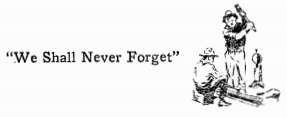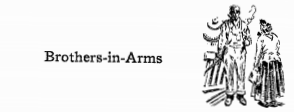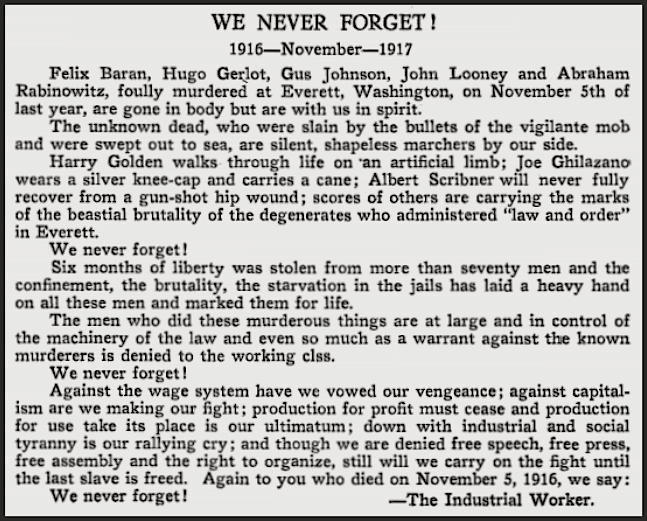Don’t worry, Fellow Worker,
all we’re going to need
from now on is guts.
-Frank Little
Hellraisers Journal, Saturday January 5, 1918
Reprinted from The Masses: Part II-Harold Callender on the I. W. W.
From the International Socialist Review of January 1918:
The Truth About the I. W. W.
By HAROLD CALLENDER
EDITOR’S NOTE: Harold Callender investigated the Bisbee deportations for the National Labor Defense Council. He did it in so judicial and poised and truth-telling a manner that we engaged him to go and find out for us the truth about the I. W. W., and all the other things that are called “I. W. W.” by those who wish to destroy them in the northwest.-The Masses.
[Part II]
—–
—–
Perhaps the funeral tribute to Little by the working people of Butte may be considered the reply to the warning which the lynching constituted. About 7,000 marched to the cemetery, representing most of the labor unions of the city. As the casket was lowered into the ground the last thing seen was a pennant of the Industrial Workers, bearing the words, “One big union,” lying across the coffin. At the headquarters of the mine union there hangs a photograph of Little, and under it, “Frank Little, victim of the copper trust, whom we shall never forget.” When I saw James Rowan, secretary of the Lumber Workers’ Industrial Union, in the county jail at Spokane, Wash., he wore on a lapel of his coat a button bearing a picture of Little and the motto: “Solidarity.” Behind him sat a youth in khaki, fingering a rifle and watching him as he talked.
“Yes, I know they want to hang me, I’ve heard it said on the streets,” said Tom Campbell, president of the miners’ union, smiling grimly as he walked to the hall to preside over a meeting of the strikers. And Campbell, dark-haired, round-faced, veteran of bloodier strikes, goes to the hall every day, directing the strike and the care of families of miners. “Winning a strike,” says Campbell, “is only part of the fight. After the companies accept our terms, we shall have to keep a close watch on them to see that they maintain them. This never ends. There’s no such thing as industrial peace while industry has to be carried on in this manner.”
The most perplexing feature of the Butte struggle is the relationship between the Metal Mine Workers’ Union and the older bodies. There is the spectacle of the membership of trade unions giving large sums of money to the miners’ strike fund, while the leaders in the local labor council, with an ecclesiastical sectarianism, condemn the new union because it doesn’t belong to the American Federation of Labor. There are officials of the state federation refusing to treat with the highly organized Metal Mine Workers as a body, but offering to accept them as individuals. There is the apparent inability of the local labor council to recognize officially that there is a strike, because the new union is not affiliated with it, and it can recognize no mine union but the inconsequential one of the Mine, Mill and Smelter Workers, which is properly affiliated with everything but the men who work in the mines.
Nineteen twentieths of the mining industry of the town is completely shut down, yet one labor official said, “I don’t consider that there is any strike.” The state Metal Trades Council and the local Metal Trades Council are engaged in a debate as to whether the affair is a strike or a lockout in regard to the metal trades, the state body standing firmly on precedent and rule and technicality, the local body anxious to help the 12,000 miners win, but desirous of avoiding expulsion from the federation of labor. “There’s more politics in the American Federation of Labor than in the Republican party,” said an observant unionist. And there seems to be, occasionally, at least, as much legal barbed wire entanglement as in a properly bound judiciary.
* * *
Some of the trade unionists at Butte fear that the Industrial Workers will capture the new union, officers are convinced they have already captured it. There are many Industrial Workers in the miners’ union, for several of its officers have been members of the Industrial Workers. The Metal Mine Workers’ Union is an industrial union, admitting specifically “all persons employed within and around the mines, or in any way connected with the mining industry,” and its preamble to the constitution says “only an industrial organization can be of any use; other forms have proved useless.” That its present spirit is distinctly aggressive and tinctured with revolutionary zeal is undeniable. As to the main organization at Butte and the new unions at Anaconda and Phillipsburg, Mont., they have affiliated with it. A speaker at one union meeting said, “This isn’t a strike merely for wages or hours: we want an arrangement that will secure justice and put an end to this bickering: we want Uncle Sam to take over these mines and run them.” There was an outburst of applause. And the “company newspaper” pleads for a “reasonable, conservative union.”
—–
The significant thing is the drawing together of the forces of labor in spite of old animosities. A man prominent in the American Federation of Labor on the Pacific Coast, being asked what was the relationship between the trade union group there and the Industrial Workers, said: “Pretty close.” A trainman in Montana, discussing the industrial skirmishes that already had produced stockades and military jails, drew from his pockets a red card along with a certificate of membership in a railroad brotherhood, and said, “It’s a two-card business from now on.” He said that fifty per cent of the men on his line had adopted the “two-card system.”
These men were not syndicalists, for they admitted they didn’t thoroly understand, much less advocate, just what the syndicalists were driving at (any more than do most of the followers of the Industrial Workers; but they know, for instance, what it is to work 3,000 feet down in a copper mine for $5.25 a day, when a three-room hut in Butte costs $35 a month and groceries are dearer than in New York. They know, most of them, what industrial unionism means, and they have an acute sense of the common interests of working men. You can’t tell them that Frank Little, the Industrial Worker leader, was lynched at Butte because of what he said about the United States army. They know that the reason twelve hundred working men were driven into cattle cars at Bisbee, Ariz., and deposited in the desert was not that their leaders had cast aspersions on the government.
One finds this attitude pronouncedly among trade unionists in the northwest, from Butte to Seattle. When missionaries of the revolutionary union were corraled by soldiers on no charge but that of causing strikes, the reiterated explanations of chambers of commerce that “the Industrial Workers of the World is not a bona fide labor organization” failed to beguile the trade unionist. When two states enacted laws making it a crime to hold membership in a union that advocated sabotage, or to rent a hall to such union, and several other states were considering similar statutes, they saw what was up. They didn’t believe in sabotage (certainly not in shouting about it, at any rate), but they realized that if the practice of choking organizations of working men who admittedly were violating no law were to go on, there was no telling where it might end. There had been hardly more denunciation of the Industrial Worker as an “agitator” than there had been of the “walking delegate.” So it was that the Spokane, Wash., Central Labor Council went so far as to request a general strike as protest against the arrests of Industrial Workers by soldiers.
But there is more than tacit recognition of a common enemy: there is, here and there, a largely unexpressed belief that the two organizations are in a definite way complementary, the Industrial Worker giving expression to discontent, the trade unionist often following with the machinery for maintaining collective bargaining after the outburst of revolt has subsided and the Industrial Worker has flitted to more spectacular service.
While the Industrial Worker looks to a radical change in industry that appears Utopian to the average trade unionist, he is seeking to bring it about by a principle that tacticians generally in the northwest, at least, are accepting—industrial unionism. “We’re all industrial unionists now, tho we can’t turn all the craft unions into industrial unions at once,” is a comment frequently heard. And the trade unionist who looks ahead fancies a time when the jurisdiction squabble will not divide the forces of labor. He usually denies that the Industrial Worker has had much to do with the growth of industrial bargaining, but he evinces a willingness to let him share in the process where he can. He prefers an Industrial Worker union to no union, and sometimes gives it his support. In Montana and Arizona the International Union of Mine, Mill and Smelter Workers, the American Federation body, has failed to prevent encroachments by the Industrial Workers, and the miners in those states adhere either to independent unions that have grown up locally or to the Industrial Workers. Trade unionists are disposed to support these unions in time of stress.
Within the Federation of Labor, too, there is a distinct tendency toward wider organization than the craft union. At Seattle fourteen craft unions employed by the Seattle Construction and Dry Dock Company have made a blanket contract providing that the breach of the agreements made as to wages and conditions of workmen in one union would annul the contracts with the others. If the company should infringe on the rights of a single craft, it would find all the other crafts joining in the fight instead of staying at work. This unique agreement includes building employees—janitors and elevator operators; and it specifically gives the workmen the right to refuse to handle any material in the shipyards that comes from industries that do not recognize organized labor. There you have a distinct step toward industrial unionism.
This tendency is not, of course, uniform, for it was recently that the Shingle Weavers’ Union found it advisable to abandon an effort to enroll the timber men and let them have a union of their own. But it is undeniable that in the woods and mines and shipyards of the Northwest the industrial union is developing form, and in the warfare of the future there probably will be little trouble over what it calls itself. The very structure of the labor movement is shifting perceptibly, for it has to meet varying conditions, such as a shipbuilding industry twice as large as it was three years ago.
Understanding the I. W. W.
And there are signs, moreover, that a public understanding of the real aims of the Industrial Workers, is coming about, in spite of the campaign of misrepresentation.
In North Dakota, the governor, Lynn J. Frazier, a farmer, took the remarkable stand early in the summer that if the Industrial Worker violated no law, neither would the employers be allowed that privilege. In a proclamation the governor mentioned the assertions that a “lawless element” was burning crops and destroying farm machinery. He suggests that anyone found committing such depredations be tried in the accustomed fashion,
“It is charged” he says, “that the constitutional rights of individuals have been trampled under foot by mobs in the guise of so-called safety committees, defense leagues and vigilance committees. To some of these misguided mobs and officers it seems to be a crime to be seeking work and not to possess money. Men have been illegally searched, beaten, deported.” The governor makes it clear that he doesn’t believe in such actions.
But that was in a state where the farmers were considering making a contract as a body with the Agricultural Workers’ Industrial Union, one of the Industrial Workers’ organizations. Most of the transient farm workers in North Dakota are Industrial Workers, and they have maintained uncommonly cordial relations with the farmers. When the Nonpartisan League submitted the proposal for a contract with the Industrial Workers, it found many farmers favorable to the plan. At the meetings when the proposal was submitted farmers told of their experiences. Some said they had long been hiring Industrial Workers exclusively, others said they wouldn’t let one in their employ. A few left the Nonpartisan League because of its championship of the Industrial Workers. But the farmers in the North are learning to deal with the Industrial Worker in a spirit of understanding. For these men, who have organized a political force to bring about state ownership of elevators, warehouses, storage house and packing plants have got an economic insight that takes them beyond the point of looking on the Industrial Worker as an agitator whom society should suppress. Victims themselves of business piracy, they are coming to see the social cause for the Industrial Worker.
Many who ought to know better look upon the Industrial Worker as a sort of modern guerilla warrior on the industrial system. They are convinced he isn’t very important, merely spectacular. “The Industrial Workers are just a big noise,” said a lawyer who had seen them operate in Arizona. “If the newspapers didn’t give them such an unmerited amount of free advertising, they’d die out.” He was distinctly mistaken.
The Industrial Workers have an organization that is national and embraces a dozen great industries. It is not very compact; it cannot be, dealing with men to whom a home is an impossible luxury, men who are made migratory by their work. The membership fluctuates widely, but has been increasing steadily. It is something like a bank account, deposits and withdrawals offsetting each other, but not varying that greatly. Its members come and go, joining during a strike but dropping out afterward. It is difficult for the officers themselves to tell what the membership is at a particular time. At Bisbee, Ariz., there were a few Industrial Workers in the copper mines before the strike of last July. When these walked out, at least two thousand others walked out. They were actuated not by a revolutionary spirit, but by inability to stand the treatment of their employers, especially when a strike by other workmen offered an opportunity to effect a change. These men attended the missionary meetings of the Industrial Workers in the city park and many were converted. Then came the deportation, and the necessity for union made more Industrial Workers. I talked to scores at Columbus, N. M., at the refugee camp, who said they were members of no union before the strike but had since joined the Industrial Workers. These men are now scattered, and when another strike comes wherever they are working they will join it and again be Industrial Workers.
Every member is an organizer, every member dispenses cards to his converts and collects their dues, which he scrupulously sends to the union. There are only a few unions, about a dozen, each union embracing an industry: the ideal of the Industrial Worker is “one big union.” Each union is divided into district branches on geographical lines, and each district has an executive committee and secretary-treasurer. There are no other officers, except the national executive committee and secretary, and the same officers in each industrial union.
Only the membership by vote may call a strike, “except in case of emergency;” but such is the informality and cohesion of the organization that a strike call by a secretary is almost tantamount to a strike. A sort of “straw vote” is usually taken in advance, and often there is no other vote. It would be difficult for the members of a union to ballot on a strike proposal and would require a long time.
There are eleven industrial unions, with others in process of formation: Marine Transport Workers Union No. 100 (Atlantic Coast), Metal and Machinery Workers, Agricultural Workers, Lumber Workers, Construction Workers (composed mostly of laborers on railroads and the comparatively unskilled in similar industries), Railway Workers (embracing men employed in any way in transportation), Marine Transport Workers Union No. 700 (Pacific Coast), Metal Mine Workers, Coal Miners, Textile Workers. A union of domestic servants has been started on the Pacific Coast.
The Industrial Workers operate chiefly among the unskilled and immigrant workers whom the trade union does not reach. They organize the men who dig tunnels and lay railroad ties and cut trees in the forests-the most poorly paid and ill treated. They speak for those whom a shortsighted society ignores; theirs is a voice from the bottom. And it is answered with military stockades!
Leaders and teachers among the Industrial Workers are capable men-and women—preaching a doctrine of revolution. They are adept at capitalizing a situation, at selecting and directing forces of revolt. But the bulk of the membership are hardly syndicalists, usually followers of a militant union that offers service in their behalf.
At the Industrial Worker headquarters at Seattle, are death masks of the five “fellow workers” killed at Everett, Wash., when armed deputy sheriffs fired on the Industrial Workers’ boat as it touched the wharf. There’ll be more “bloody Sundays,” and more deportations, and some day we may learn that they won’t solve the problem of human misery.—From The Masses.
[Emphasis and paragraph breaks added.]
———-
SOURCES & IMAGES
International Socialist Review Volume 18
(Chicago, Illinois)
Charles H. Kerr and Company
July 1917-June 1918
https://archive.org/details/ISR-volume18
ISR Jan 1918
https://archive.org/stream/ISR-volume18#page/n165/mode/1up
“The Truth About the I. W. W.” by Harold Callender
https://archive.org/stream/ISR-volume18#page/n171/mode/1up
See also:
Tag: World War I Repression
https://weneverforget.org/tag/world-war-i-repression/
The Masses
(New York, New York)
-Nov & Dec 1917
http://dlib.nyu.edu/themasses/books/masses079
“The Truth About The I. W. W.” by Harold Callender
http://dlib.nyu.edu/themasses/books/masses079/4-5



